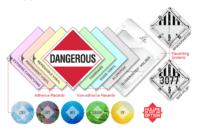Say you need a replacement 420 Wh battery for your electric snowblower. Instead of ordering a new one from the manufacturer, you find an online retailer offering a used battery at a discount. When the battery arrives, you—being somewhat knowledgeable about the rules governing transport of lithium batteries—are surprised to see it’s in a plain,…
7 misconceptions about attending the Dangerous Goods Symposium
Have you ever attended Labelmaster’s Dangerous Goods Symposium? If so, here’s what you need to know right now: The 2020 Dangerous Goods Symposium will be held September 9-11 in Chicago You’ll save $50 by registering by April 30, 2020. Now, if you’ve never attended the DG Symposium, you might have a reason or two why…
Hazmat Quizmaster: Do you know how to ship lithium batteries by air?
KEEP YOUR LITHIUM BATTERY SHIPMENTS COMPLIANT Lithium batteries are hazmat, and the regulations for shipping them change often. Keep your shipments safe and compliant with a complete line of lithium battery resources from Labelmaster. Make sure your shipments are safe and in complete compliance with a full line of solutions from Labelmaster—a full-service provider of goods and services for hazardous materials…
DOT PHMSA Hosts First Lithium Battery Air Safety Advisory Committee Meeting
Last week DOT PHMSA hosted the first Lithium Battery Air Safety Advisory Committee meeting at DOT Headquarters in Washington, D.C., and I had the pleasure of the attending the meeting alongside Labelmaster Services V.P. of Consulting, Pia Jala. Lithium cell and battery production throughout the world continues to grow at an astonishing rate due to…
Why it’s absolutely essential to choose the right hazmat placard
True fact: No one ever got promoted for choosing the right hazmat placard. Choosing the wrong placard, however, could have negative consequences for anyone’s job prospects. Think about it. Every Dangerous Goods shipment represents a significant investment in time and materials, and it could be part of a supply chain impacting several organizations. Yet one…
Hazmat hopes 2020: If Dangerous Goods professionals ran the world
Every fall, we invite everyone who attends the Dangerous Goods Symposium (and lots of other hazmat pros) to answer one simple question: If you could wish for one thing in the entire Dangerous Goods galaxy, what would it be? Now, for the third straight year, we’ve compiled those answers to kick off our year with…
8 minor miracles in honor of the first-ever hazmat Hanukkah
It’s the holiday season, so naturally it’s time for a holiday post. And this time we’re doing something different. We’ve done holiday gift guides. We’ve also done Valentine’s Day, Mothers’ Day, Fathers’ Day, Independence Day and, of course, Halloween. But as far as we know, no one’s ever done a Hanukkah-themed post about Dangerous Goods…
Revisiting the most important 2019 hazmat regulations—and previewing 2020
The biggest regulatory news in 2019 may have been something that didn’t happen—PHMSA’s HM-215O International Harmonization rule, which would have aligned U.S. regulations with the most recent UN Model Regulations, ICAO Technical Instructions and IMDG Code. HM-215O will almost certainly be formalized in 2020. Meanwhile, here’s a look back at the significant regulatory developments that…
DOT’s Check the Box making progress against undeclared Dangerous Goods
Hazardous Matt is on a roll, and the “plain brown box” is in retreat. This time last year we took a first look at the U.S. Department of Transportation’s Check the Box program, a multimedia campaign that addresses the ongoing problem of undeclared Dangerous Goods—also known as the “plain brown box.” The star of the…
Why the new lithium battery test summary rules are nothing to stress out about
On January 1, 2020, a new regulation goes into effect that will impact every organization that manufactures or distributes lithium batteries and/or the equipment they power. These companies will be required to share information, known as a “test summary,” that proves their batteries meet the testing standards as defined in sub-section 38.3 of the UN…









